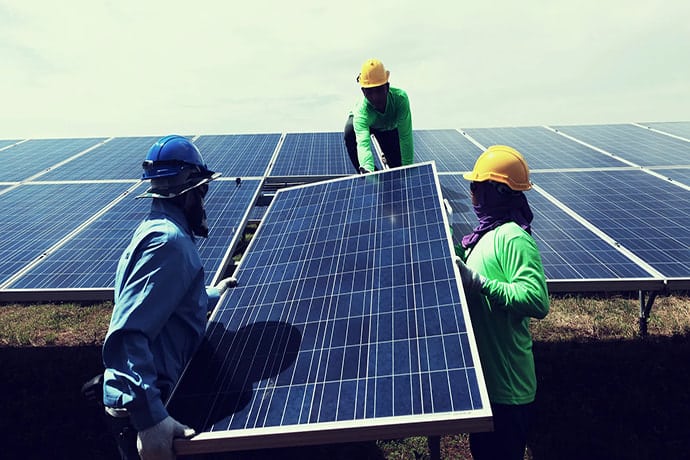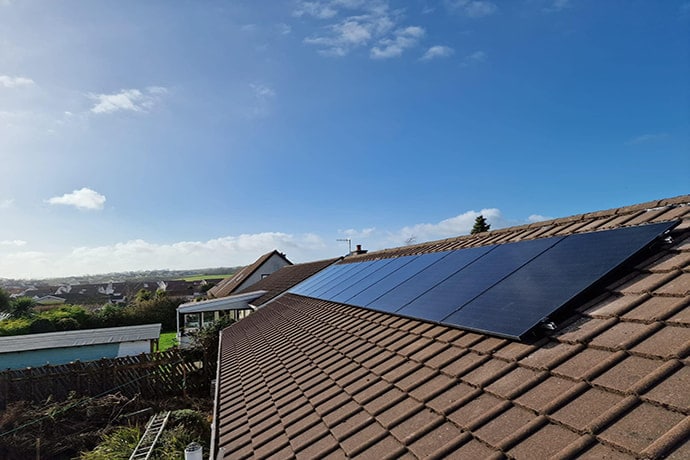1. What is photovoltaic solar panel power? What is distributed photovoltaic power generation?
Photovoltaic solar panel power generation utilizes the principle of the photovoltaic effect of semiconductor P-N junction and uses solar cells to convert solar energy directly into electricity.
Distributed power generation refers to photovoltaic power generation facilities that are constructed near the user’s site and operated in such a way that self-generation and self-consumption is the main mode of operation on the user’s side, and excess power is fed into the Internet, but balanced regulation of the distribution system is a characteristic.
Distributed power generation follows the principles of local conditions, clean and efficient, decentralized layout, and nearby utilization, making full use of local PV resources, and replacing and reducing fossil energy consumption.
2. What is building PV integration?
Building Integrated Photovoltaic (BIPV) is the integration of solar power technology into buildings, using solar photovoltaic materials to replace traditional building materials, making the building itself a large energy source. Utilizing BIPV technology, solar cell materials are integrated into the building envelope such as roofs and walls.
3. What is “Self-generation and self-consumption, surplus electricity on-grid”?
“Self-generation and self-consumption, surplus electricity on-grid” means that the electricity generated by photovoltaic solar panel is prioritized for use by their loads, and the excess electricity is sold to the grid; when the electricity generated by PV is not enough for use by the loads, it will be supplemented by the grid.
“Self-generation and self-consumption with on-grid utilization” is a mode with higher income, and at the same time reduces the impact of PV on the power grid.
For this mode of operation, there are generally two meters, one is a meter to measure the electricity generated by the PV; the other is a bidirectional meter to measure the upstream and downstream electricity of the grid.
4. Why does the load prioritize the use of electricity generated by photovoltaic solar panel?
You can use the inverse method, assuming that the load priority with the power grid, PV power can only flow to the grid, but the same section of the line in the power can only have a direction, so the PV will be prioritized for the use of the nearest load.
At the same time, when the power of PV is greater than the load, the voltage of PV is always a little higher than the voltage of the grid (depending on the impedance of the line).
5. Can electricity that cannot be used by the PV plant be stored for use at night?
The electricity generated by photovoltaic solar panel will be sold to the grid and distributed to other places through the grid if the load cannot consume it in time.
If you want to store the excess electricity for further use, you need to configure PCS and storage batteries to store the excess electricity in the batteries first, and then release the electricity from the storage batteries for use by the load at night or when needed.
6. What are the benefits of installing a photovoltaic power generation system for homeowners?
- The roof is beautiful and generous, with heat insulation and heat preservation. Installing a PV power plant on the roof can protect the roof well. In summer, PV panels can absorb heat, so that the indoor temperature is not too high, and indoor air conditioning will be more energy efficient.
- Roof photovoltaic power plant for the factory’s use, saving electricity and earning income. Factory industrial and commercial photovoltaic power plant feed-in tariffs are higher, the power plant after the grid has a higher income, and photovoltaic power plant power priority for self-consumption, you can save the enterprise’s electricity expenses. Every year the enterprise saves a large sum of money.
- Revitalization of enterprise assets, enhancement the external environmental protection and energy saving, and green image of the enterprise is conducive to the long-term development of the enterprise.
7. What is the capacity of the PV plant I can install and approximately how much electricity can I generate per year?
The installed capacity of a roof is related to the type of roof and the installation method, in general.
Roof capacity = total roof area x roof utilization rate x installed capacity per square meter (180~200WP)
Assuming the total roof area is 10000m2.
If it is a flat-colored steel tile, about 10000*0.8*200Wp=1.6MWp can be installed.
If it is a concrete roof, it can be installed 10000*0.6*200Wp=1.2MWp.
As for how much electricity can be generated each year, you can use the annual equivalent hours of the region * installed capacity. The annual equivalent hours can be obtained by checking the table or meteorological data.

8. How much does it cost to invest in a PV plant? How long will it take to pay back the capital?
The investment cost of the power plant is generally affected by the business model, equipment cost, total construction amount, etc. The price in the past two years is 0.89~0.89%. The price is around 0.89~1.01 USD/W in these two years. Taking a 1MW power plant as an example, the cost of investing a single watt is 1 USD/W, and the total investment is 1 million dollars.
The payback period of the power station is generally affected by irradiation conditions, integrated tariffs, the proportion of photovoltaic self-consumption, the stability of the power station, and other factors.
Such as the United States residential electricity: city 10 cents / kWh, 100% consumption, annual utilization hours of 1200h, no loan interest.
Total investment of one million dollars ($1,000,000)
Annual electricity production = 1 MW × 1200 hours = 1,200,000 kWh
The price of electricity is 10 cents/kWh, or $0.1/kWh.
Now, substitute these values into the formula:
Payback cycle (years) = $1,000,000 / (1,200,000 kWh × $0.1/kWh) = 8.33 years
Therefore, the payback period of the above power plant is about 8.33 years.
9. Is the annual power output of photovoltaic solar panel fixed? What are the factors related to it? Will there be any degradation?
The annual power generation of distributed PV power plants is not fixed, generally affected by the following factors:
- Installation location: mainly affected by the local light conditions, temperature, and environmental conditions, such as the environmental conditions of the Suzhou area in China, the annual utilization hours of the PV system in the 1100 hours to 1300 hours or so.
- Installation angle: The installation angle of PV modules directly affects the angle of light, thus affecting the power generation efficiency.
- Product quality of PV system: Adopting reliable and stable PV system products can reduce the equipment failure time and improve the system utilization rate, thus increasing the power generation. The core products include PV modules, inverters, and so on.
- Operation and maintenance: PV modules need to be cleaned after the accumulation of ash on the surface, and untimely cleaning may affect the efficiency of PV power generation. At the same time, regular inspection and maintenance of the PV system can reduce the failure rate of the PV system and improve power generation.
In addition, the rated output power of PV modules will decay every year, generally by 2.5% in the first year and by 0.55% every year thereafter.
10. Can a photovoltaic solar panel mounted on a roof cause a fire?
The safety of correctly installed PV plants is relatively high. The causes of PV plant fires come from module hot spots, arcing caused by DC plugs or cables, and lightning.
Component hot spot from the local shadow blocking, as long as diligent operation and maintenance can be avoided, DC arc currently also has a corresponding detection means, can be detected to prevent this type of failure.
Lightning is easy to induce risk to power plants, so we should pay attention to checking whether the power plant grounding is good and whether corrosion.
Distributed power generation system is prohibited near the piles of flammable and explosive substances, in addition to the need to reserve fire and maintenance access (backup fire extinguishing equipment).
Source: Sungold
To learn more about photovoltaic, please click: https://www.sungoldsolar.com/


























